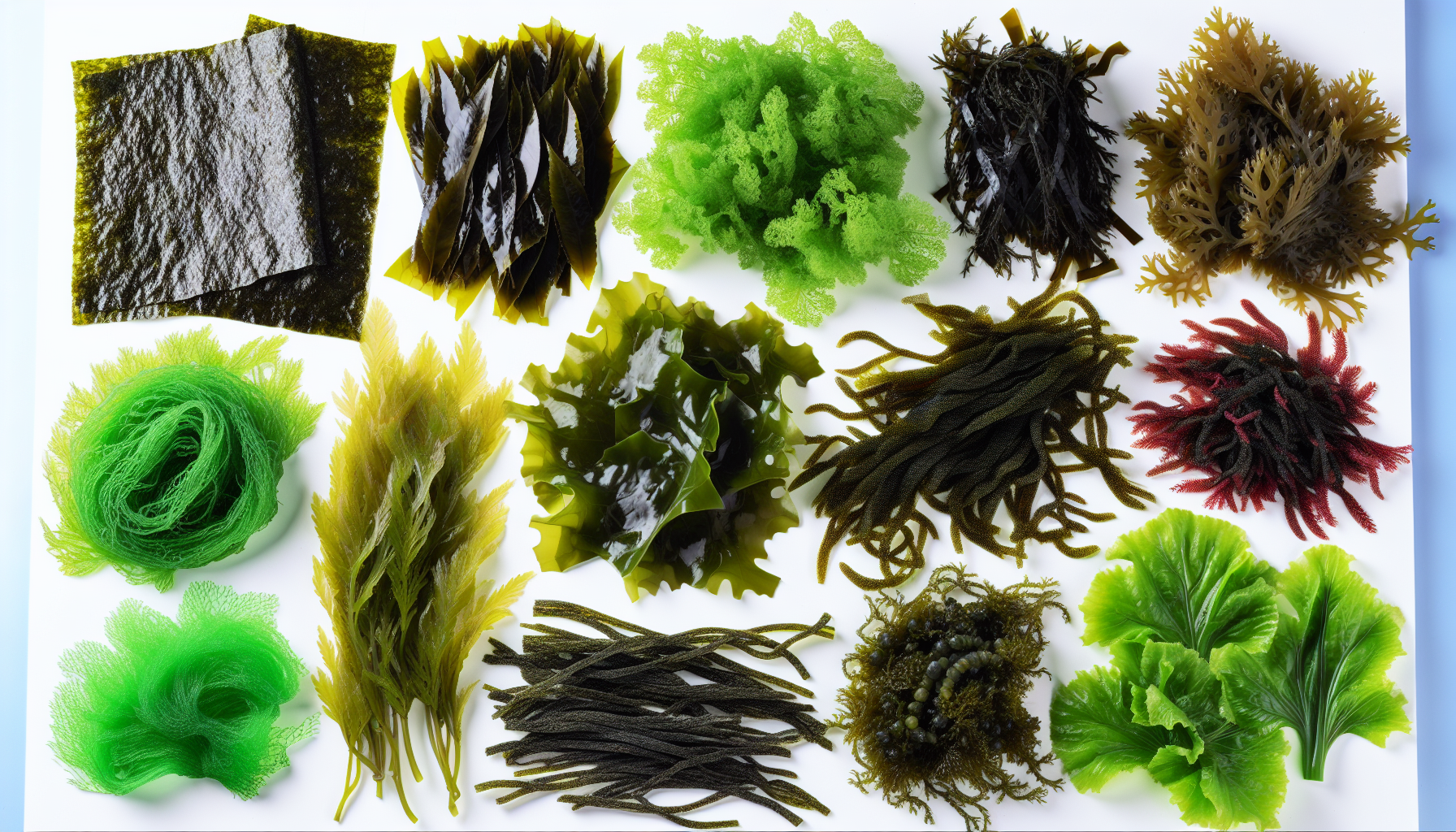The Ultimate Guide To Longevity: Benefits Of Seaweed And Sauna Therapy
As we decode the mysteries of longevity, “seaweed and sauna bathing” stand out as key players in longevity. This article sheds light on why these traditions have been associated with longer lifespans and how they can be integrated into your life today. Dive in to understand the health benefits that have catapulted eating seaweed and enjoying saunas to the forefront of anti-aging practices.
Unlocking the Secrets of Seaweed

Seaweed may not be the first thing that comes to mind when you think of superfoods. Yet, this marine plant has been a staple in coastal cultures like Japan for centuries. It contributes to a staggering 20% of meals, offering a wealth of nutrients and health benefits.
Seaweeds are classified into three groups: green algae, brown algae, and red algae. Each group significantly contributes to marine life by providing food and shelter for various organisms, thus promoting a healthy aquaculture. Seaweed is more than just a food source; it’s also a phenomenal health booster.
The magic of seaweed lies in its molecular effects. When consumed, seaweed triggers the production of antioxidants, reducing cell-level inflammation. It also helps protect against cellular damage, facilitate tumour suppression, support immune function, and regulate cellular quality control. In essence, eating seaweed could be one of nature’s best prescriptions for health and longevity.
Types of Edible Seaweeds
While most seaweeds are edible, there are a few exceptions that are either not palatable or potentially harmful. For instance, certain types like Desmarestia can be acidic, while others like Laurencia might produce bromides. It’s important to note that the suitability of seaweed for eating can depend on various factors, including where it’s grown and how it’s processed.
Nori, predominantly used for wrapping sushi, is a rich source of iodine and can help prevent iodine deficiency. Another popular type is wakame, characterized by its slightly sweet and umami taste, along with a silky and tender texture.
Both nori and wakame are delicious and also packed with health benefits but so are most seaweeds! The world has discovered Sea Moss, but all Seaweeds are rich in nutrients and can assist in everything from:
- blood sugar control
- thyroid health
- improving digestion
- boosting immune function
- promoting heart health
- supporting weight loss
The benefits of seaweed are so extensive that incorporating it into your diet could be one of the best health decisions you make.
Eating seaweed regularly is a simple yet effective way to boost your health and longevity. As it becomes increasingly popular in the western world, it’s easier than ever to include this superfood in your diet, whether through sushi, salads, or even as a tasty snack. If you live on the coast you can harvest it yourself. If you are in-land, go to your local health food store and buy it dried or powdered.
Nutritional Powerhouse
Seaweed is truly a nutritional powerhouse. Offering up to 92 minerals it is packed with essential nutrients like:
- Sodium
- Magnesium
- Phosphorus
- Iodine
- Potassium
- Iron
- Zinc
Seaweed offers so many Vitamins, almost ALL the vitamins. Moreover, it’s a rich source of prebiotic fiber and helps to improve gut health by feeding your good bacteria and improving gut flora.
Seaweed isn’t just a boon for gut health; it also contributes to reducing the risk of diabetes. Seaweed compounds have been found to reduce inflammation, lower glucose and improve insulin sensitivity, as well as lower high fat levels in the bloodstream. These potential health benefits only scratch the surface of what seaweed can do.
In a world where many of us struggle to meet our nutritional needs through diet alone, seaweed offers a concentrated dose of essential nutrients. It’s literally the best multi-vitamin and most bioavailable multi-vitamin on the market!
Seaweed and Heart Health
Seaweed benefits extend to the heart as well. Its high fiber and antioxidant content help protect the heart and reduce cholesterol levels, promoting cardiovascular health. Seaweed contains compounds like:
- Fucoidan
- Fucoxanthin
- Astaxanthin
- Phlorotannin
which may contribute to heart health. Combined with the cardiovascular benefits of regular sauna therapy, the consumption of seaweed could be a powerful approach to enhancing overall well-being.
In fact, the benefits of seaweed extend beyond the heart. The various nutrients found in seaweed can contribute to better brain health, improved digestion, and even more radiant skin. The potential health benefits of seaweed are truly remarkable.
The power of seaweed for heart health cannot be understated. Whether you’re looking to improve your heart health, manage your weight, or boost your overall wellness, incorporating seaweed into your diet could be a step in the right direction.
How to Eat Seaweed
The thought of eating seaweed might seem strange to some, but it’s a dietary staple in many cultures. Seaweed can be incorporated into dishes such as rice bowls, soups, or stews, and it also serves as a delightful roasted snack.
The most common way to consume seaweed is through sushi, where it’s often used as a wrapping or flavouring element. However, there are countless other ways to enjoy this nutritious food. Here are some ideas:
- Add it to salads for a unique texture and flavor
- Use it in stir-fries for a hint of umami
- Blend it into smoothies for added nutrients
- Roast it and enjoy it as a crunchy snack
Seaweed can be a versatile addition to your diet.
You can easily find seaweed at most major retailers, and specialty Asian markets often offer a diverse selection of dried seaweed and seaweed snacks. And if you’re new to seaweed, there are plenty of simple recipes to get you started. Some straightforward options include:
- Rice & Quinoa Prawn Sushi Bowl
- Vegan Kimchi
- Beetroot & Avocado Nori Rolls with Wasabi Dipping Sauce
- Seaweed Fried Rice with a sprinkle of roasted nori and sesame seeds.
Remember, although seaweed is nutrient-rich, moderation in consumption is vital. Too much of a good thing can sometimes lead to health issues, especially if the seaweed is contaminated with heavy metals or other toxins. As with any food, balance is key.
The Healing Power of Sauna Bathing
Just like seaweed, sauna bathing offers numerous health benefits. From improved cardiovascular function to detoxification and immune system support, sauna bathing could be a secret weapon for health and longevity.
The use of a sauna induces a mild form of hyperthermia, triggering the activation of heat shock proteins and other hormetic responses. This process aids in the body’s detoxification by promoting the excretion of toxins through increased sweating.
Sauna bathing also supports the immune system. It has been found to reduce the incidence of common colds and is linked to changes in immune pathways.
Moreover, sauna bathing offers general health benefits such as cognitive improvements and enhanced performance for athletes. When the benefits of sauna use are combined with the nutritional potency of seaweed, a synergistic effect is created that significantly boosts overall well-being.
Traditional Finnish Saunas vs. Infrared Saunas
While sauna bathing is a universal practice, there are different types of saunas, each offering unique experiences and benefits. Traditional Finnish saunas use dry heat and involve brief exposure periods with dry air. On the other hand, infrared saunas employ infrared emitters to directly heat the body at lower temperatures.
Regardless of the type, both traditional Finnish saunas and infrared saunas offer numerous health benefits, including:
- Reduction of blood pressure
- Provision of anti-inflammatory and antioxidant properties
- Stress reduction
- Detoxification of the body
- Skin cleansing
- Protection against respiratory infections
- Pain relief
- Enhancement of cardiovascular and mental health
Choosing between a traditional sauna and an infrared sauna ultimately depends on individual preferences. Some people prefer the intense heat of a Finnish sauna, while others may find the direct heat of an infrared sauna more comfortable.
Regardless of the chosen sauna type, the health benefits remain uniform. Regular sauna use can enhance overall well-being, and when paired with the nutritional advantages of seaweed, it forms a potent mix for bio-hacking your health and improving longevity.
Cardiovascular Benefits
One of the most significant benefits of regular sauna use is improved cardiovascular health. Research indicates that regular sauna use is linked to a reduced risk of heart disease and stroke, as a result of improved cellular heat stress tolerance.
Sauna bathing has been shown to cause an immediate decrease in both systolic and diastolic blood pressure, as well as a reduction in pulse wave velocity after exposure to heat.
To achieve cardiovascular health benefits, it is advised to engage in three to seven sauna sessions per week, which can be considered as a form of repeated sauna therapy.
In conclusion, the cardiovascular benefits of sauna use are substantial and well-documented. Whether you’re aiming to improve your heart health, reduce stress, or enhance your overall wellness, sauna bathing can be a valuable addition to your lifestyle.
Boosting Immunity Through Heat Stress
Sauna bathing can also boost immunity. The heat stress induced by sauna bathing activates the body’s natural defense mechanisms. Sauna bathing has been found to reduce the incidence of common colds by half and is linked to changes in immune pathways, such as alterations in interleukin 6 (IL-6) and interleukin 10 (IL-10) levels, which play a role in the immune response to heat stress.
However, like any health practice, sauna bathing should be done safely. Some of the documented adverse effects of sauna bathing include:
- Mild to moderate heat discomfort and intolerance
- Low blood pressure/light-headedness
- Transient leg pain
- Airway irritation
- Claustrophobia
The key is to listen to your body and adjust your sauna use accordingly. With proper precautions, sauna bathing can be a safe and effective way to boost your immunity and overall health.
Integrating Seaweed and Sauna into Your Lifestyle
Changing up your lifestyle takes a little planning but is pretty easy! There are salts and sauerkraut at the grocery store that incorporate seaweed flakes. Powdered seaweed is available at most health stores that can be easily added to any dish.
Whether you’re incorporating seaweed seasoning into your dishes or using it as a healthy substitute for salt, seaweed can be a versatile addition to your diet:
- Salads
- Sushi rolls
- Soups and stews
- Stir-fries
- Smoothies
Finding A Sauna For Public Use
On the other hand, getting into a sauna requires a bit more planning but can be equally beneficial. Whether you prefer traditional saunas or infrared saunas, the key is to be consistent and safe. This includes proper hydration, listening to your body, and following guidelines for duration and frequency.
You can use search engines like Google to look for saunas in your area. Simply typing “saunas near me” or “public saunas in [your city]” should give you a list of available options. Try the term “bath house” if you don’t find anything.
Another method is to check with local gyms, spas, health clubs, or hotels, as many of these establishments offer sauna facilities. Additionally, there are apps and websites dedicated to locating wellness facilities, including saunas, which can be very useful. Social media and community forums can also be great resources for recommendations and reviews from people who have used saunas in your area.
Integrating “seaweed and sauna” into your lifestyle doesn’t have to be complicated or daunting. With a bit of thoughtful planning, these health-boosting practices can be seamlessly incorporated into your daily routine.
Sauna Etiquette and Safety
Sauna etiquette and safety are vital to ensure a beneficial and enjoyable experience. Before entering a sauna, it is advisable to consume one to two glasses of water and take a shower to ensure proper hydration.
When using a public sauna, there are a few things to keep in mind:
- Enter and leave quickly and quietly
- Adhere to the dress code or lack-of-dress code
- Use a towel
- Seek permission before pouring water on the rocks
- Shower beforehand
- Respect others’ privacy and personal space
- Maintain silence
- Be mindful of your space.
The duration of sauna usage should also be respected to promote safety and prevent dehydration and other potential negative effects. It is generally advised to limit sauna usage to 15 to 20 minutes.
Lastly, always listen to your body. If you start to feel discomfort, dizziness, drowsiness, nausea, or general malaise, it’s crucial to promptly leave the sauna. Sauna bathing can offer a wonderfully relaxing and health-enhancing experience, but safe practices are paramount.
The Combined Effects of Seaweed and Sauna
Combining seaweed and sauna may offer synergistic health benefits. When used together, these natural health promoters can boost detoxification, improve mental health, and foster overall well-being.
Seaweed intake can enhance detoxification in the body by:
- promoting a healthy metabolism
- stimulating the liver, kidney, skin, and intestines to eliminate stored toxins
- improving blood circulation
- providing natural detoxification properties
When combined with sauna use, seaweed can potentially augment the detoxification process by stimulating sweating and aiding in the removal of toxins from the body.
The combination of seaweed’s nutritional benefits and sauna’s relaxation effects may also contribute to improved mental health. Seaweed contains a variety of health-promoting compounds, such as antioxidants, that can potentially enhance mental health. Similarly, sauna bathing has been shown to promote mental well-being and relaxation.
The consumption of seaweed may contribute to heart health and offer valuable nutrients. Meanwhile, the use of saunas may facilitate detoxification, enhance metabolism, aid in weight loss, improve cardiovascular function, boost immune function, and assist in stress management. All of these collectively contribute to overall well-being.
Enhanced Detoxification
Both seaweed and sauna aids in detoxification in their unique ways. Seaweed, in particular, can bind to heavy metals in the body and aid in their removal through feces, a process known as chelation.
On the other hand, sauna use promotes detoxification through sweating. The heat from the sauna induces a mild form of hyperthermia, which triggers the activation of heat shock proteins and other hormetic responses. This process helps the body excrete toxins through sweat, waste, and urine.
The detoxification effects of seaweed and sauna are further enhanced when used together. The heat from the sauna can stimulate sweating, which aids in the removal of toxins. When combined with seaweed, this process is amplified, leading to more efficient detoxification.
In conclusion, the combination of seaweed and sauna can be a powerful tool for detoxification. Whether your goal is to enhance overall health or detoxify your body, embracing these practices can be advantageous.
Improved Mental Health
Mental health is just as important as physical health, and the combination of seaweed and sauna can contribute to improved mental well-being. Seaweed, especially brown seaweed such as Ascophyllum nodosum, can potentially enhance the brain-gut connection and might exert a beneficial influence on depressive symptoms.
Sauna sessions have several benefits for mental health, including:
- Lowering cortisol, the body’s primary stress hormone
- Inducing muscle relaxation and alleviating tension
- Fostering a feeling of relaxation and reducing stress
These benefits contribute to overall mental well-being.
Research suggests that higher consumption of seaweed is linked to a lower occurrence of depressive symptoms, suggesting potential beneficial effects of seaweed on human brain health.
In conclusion, the combination of seaweed and sauna can be a powerful tool for improving mental health. Whether you’re coping with stress, anxiety, or simply seeking to enhance your overall mental well-being, these natural health promoters can be a valuable inclusion in your routine.
how much seaweed do you have to eat to benefit?
While seaweed is packed with nutrients and offers numerous health benefits, it’s important to consume it in moderation. There is no designated daily intake of seaweed recommended for maximizing health benefits, however, consuming a 5-gram portion can contribute a significant percentage of the Recommended Daily Intake (RDI) for certain nutrients.
The beneficial intake of seaweed may differ among various species because of their unique nutritional profiles, therefore necessitating potential adjustments in consumption.
Individual nutritional requirements and dietary restrictions significantly influence the consumption of seaweed. It’s important to consider the iodine content and consume seaweed in small or infrequent amounts to minimize potential health risks.
Regardless of the form of consumption, seaweed remains a source of essential nutrients such as iodine, vitamins, and antioxidants. As part of a balanced diet, seaweed can help you meet your nutritional needs and support overall health.
Detoxifying the Blood
Seaweed and sauna usage can aid in blood detoxification, thereby promoting overall health. Seaweed plays a significant role in blood detoxification by containing:
- Iodine
- Minerals
- Alginic acid
- Chlorophyll
These components facilitate the cleansing of toxins from the blood.
Saunas aid in the detoxification of blood by elevating the body temperature, leading to increased perspiration and subsequent elimination of toxins through sweat, waste, and urine.
Seaweed and sauna can help regulate glucose levels. Brown seaweed and its extracts have the potential to positively influence blood sugar levels by preventing post-meal spikes and supporting overall blood sugar regulation.
Sauna sessions have the potential to:
- Reduce blood glucose levels by decreasing fasting blood glucose
- Improve water weight loss
- Enhance insulin sensitivity
- Reduce the likelihood of blood glucose spikes.
Seaweed and Sauna for Heavy Metal Detox
Seaweed can act as a natural chelator, binding to heavy metals and aiding in their removal from the body. Seaweed functions as a natural chelator because of the presence of alginic acid in its cells.
Seaweed varieties such as Porphyra species and extracts containing edible algal acid (EAA) are recognized for displaying the highest chelating activities, thus making them particularly effective in the chelation process.
Chelation in the human body involves a biomechanical process wherein particular agents, recognized for their ability to bind toxic substances such as heavy metals, adhere to these perilous particles in the bloodstream or soft tissues. These metals are typically eliminated through urine, thereby mitigating their toxic impact on the body.
Heavy metals can significantly impact human health by:
- reducing energy levels
- disrupting the function of vital organs such as the brain, lungs, kidneys, and liver
- disrupting essential cellular processes, including growth, repair mechanisms, and apoptosis
- resulting in organ damage and environmental pollution
In severe cases, heavy metal exposure can pose life-threatening risks.
Alkalize the blood with seaweed or sea moss
Seaweed, particularly sea moss, can help alkalize the blood. It contributes to the alkalization of the blood through its significant concentration of minerals such as:
- potassium
- calcium
- magnesium
- iron
Alkalizing the blood through an alkaline diet can yield numerous advantages, such as:
- Enhanced bone health
- Decreased muscle wasting
- Weight management
- Improved kidney function
- Cancer and heart disease prevention
- Improved tissue oxygenation
- Reduced pain
- Enhanced bone strength
Research has indicated that seaweed, particularly kombu, can contribute to blood pressure regulation and the prevention of blood sugar spikes through the slowing of digestion.
The optimal pH level for human blood is between 7.35 and 7.45, indicating a slightly alkaline or basic nature. Consuming seaweed or sea moss can help maintain this optimal level, promoting a healthy pH balance and reducing inflammation.
Kelp Yourself to Lower Glucose Levels
Seaweed may help lower glucose levels. The intake of kelp can have a positive influence on glycemic control by reducing blood lipids and glucose levels, enhancing antioxidant enzyme activities and post-prandial satiety, and reducing short-term energy intake.
Specific types of kelp, such as Laminaria digitata, Undaria pinnatifida, and Acophyllum nodosum, are recognized for their effectiveness in lowering glucose levels.
In conclusion, the consumption of seaweed can help manage blood sugar levels, supporting blood sugar control and reducing the risk of diabetes.
Whether you’re managing diabetes or simply looking to improve your overall health, incorporating seaweed into your diet can be a valuable addition to your lifestyle.
How Often Should I Sauna for Health Benefits
The optimal frequency of sauna use for health benefits varies, but generally, 2-3 times per week is recommended for most individuals. Increasing the frequency of sauna bathing has been linked to a decreased risk of:
- cardiovascular disease
- all-cause mortality
- dementia
- Alzheimer’s
The suggested duration of each sauna session for maximizing health benefits is around 8 to 15 minutes. In conclusion, regular sauna use can contribute to overall well-being, and when combined with the nutritional benefits of seaweed, it creates a powerful combination for health and longevity.
Sweat Lodges
Sweat lodges are a traditional form of sauna that have been used for centuries by indigenous cultures for spiritual and physical cleansing. Much like saunas, sweat lodges were used for hygiene, health, social interaction, and spirituality. These lodges are built using saplings covered with blankets and sometimes animal skins. In modern times, wood is often used as the primary material, covered with tarps and blankets.
During a sweat lodge ceremony, the following activities take place:
- Musical accompaniment is provided
- Prayers are uttered
- Attendees are invited to speak about themselves and their motivations for participating in the ceremony, sharing their personal narratives and contemplating life.
In conclusion, the use of sweat lodges is a testament to the timeless appeal and benefits of heat therapy. Whether in a traditional sweat lodge or a modern sauna, the benefits of heat therapy combined with the nutritional power of seaweed can significantly enhance overall well-being.
Lower Risk of Alzheimers and Dimentia
Regular sauna use has been linked to a lower risk of Alzheimer’s and dementia. This could be potentially due to improved cardiovascular health and stress reduction.
The cognitive health benefits, including a decreased risk of cognitive decline and neurodegenerative diseases, are specifically linked to saunas that are maintained at a temperature of at least 78.9°C (174°F) and used for a duration of 20 minutes or more.
The recommended frequency of sauna use that may potentially reduce the risk of Alzheimer’s and dementia is either 2-3 times per week or 4-7 times per week.
In conclusion, regular sauna use can be a powerful tool for preserving cognitive health. When combined with the nutritional benefits of seaweed, it creates a powerful combination for health and longevity.
Heat Shock Proteins: All You Need To Know
Heat shock proteins (HSPs) are a family of proteins produced by cells in response to exposure to stressful conditions, such as heat shock, cold, UV light, and during wound healing or tissue remodeling. These proteins function as molecular chaperones, playing a crucial role in protein-protein interactions, such as protein folding and assisting in establishing proper protein conformation. By doing so, HSPs prevent unwanted protein aggregation and help stabilize partially unfolded proteins, aiding in transporting proteins across membranes within the cell.
HSPs are expressed under both stressful and non-stressful conditions. Under non-stressful conditions, they act as “monitors,” managing the cell’s proteins by carrying old proteins to the cell’s “recycling bin” (proteasome) and helping newly synthesized proteins fold properly. These activities are part of the cell’s repair system, known as the “cellular stress response” or the “heat-shock response.”
Heat Shock Proteins Role in Cardiovascular Health
Furthermore, heat shock proteins have a significant role in cardiovascular health. For instance, certain HSPs like Hsp90, Hsp70, Hsp27, and alpha B crystallin are reported to be involved in the cardiovascular system. HSPs are involved in managing oxidative stress and other physiological factors in the cardiovasculature.
In terms of immunity, heat-shock proteins can bind not only whole proteins but also peptides, though their affinity and specificity for this interaction are typically low. Some HSPs, such as Hsp70, Hsp90, gp96, and calreticulin, have been identified to possess this ability. They also play an important role in the proper folding of proteins involved in pro-inflammatory signaling pathways.
Amyloid-beta 42 / Heat Shock Proteins
In recent studies, there’s been an interest in exploring the role of HSPs in neurodegenerative diseases. They are known to suppress the accumulation of toxic pre-fibrillar intermediates and misfolded proteins, which are common in such conditions.
Research has indicated that heat shock protein 70 (Hsp70) play a significant role in neuroprotection against the toxic effects of intracellularly expressed beta-amyloid (Aβ42) in neurons. Heat shock proteins, like Hsp70, are like special helpers inside our body’s cells. When there’s a bad protein called beta-amyloid, which can harm brain cells, these heat shock proteins come to the rescue. They help protect brain cells by fighting off the bad effects of beta-amyloid. This is really important because beta-amyloid is linked to diseases like Alzheimer’s, where it causes problems in the brain. Scientists are studying this to find new ways to help people with these brain diseases.
Frequently Asked Questions
Does sauna increase longevity?
Yes, research has shown that regular sauna use is associated with a reduced risk of premature death from all causes, according to a study published in the Journal of the American Medical Association (JAMA) in 2015.
What are the 7 keys to longevity?
The 7 keys to longevity include: staying physically active, consuming a healthy diet rich in fruits and vegetables, getting adequate sleep, avoiding smoking and excessive drinking, managing chronic conditions, prioritizing relationships, and maintaining a positive mindset. These lifestyle modifications can contribute to a longer and healthier life.
What does seaweed do to your body?
Seaweed acts as a natural laxative due to its high-fiber content, improves digestion and circulation, enhances gut health, corrects most skin conditions, prevents cancers and tumours and is the best dietary source of iodine, supporting the thyroid gland. It also contains essential vitamins, minerals, and antioxidants that protect cells from damage.
How can I incorporate seaweeds into my lifestyle?
You can easily incorporate seaweed into your meals, snacks, or supplements and practice sauna bathing in traditional Finnish saunas, infrared saunas, or sweat lodges. Try adding seaweed to your diet and enjoying sauna sessions to experience their health benefits.
How can I incorporate saunas into my lifestyle?
Visit your community centre, local gym, spa, or search for a bath house close to you. If you are in Japan they are called Onsen. If you are in Korea, you can find a family bath house. There are many online stores that sell pre-built saunas for the home as well.
How often should I use a sauna for health benefits?
For best health benefits, it is generally recommended to use a sauna 2-3 times per week. This frequency can vary for different individuals.
References:
- Sauna Benefits Deep Dive and Optimal Use with Dr. Rhonda Patrick & MedCram https://www.youtube.com/watch?v=RWkv9ad7zvc
- Investigating the Effect of Single-session Sauna Use on Body Temperature https://clinicaltrials.gov/study/NCT04249700
- World Happiness Report 2022 https://happiness-report.s3.amazonaws.com/2022/WHR+22.pdf
- Effect of post-exercise sauna bathing on the endurance performance of competitive male runner https://www.sciencedirect.com/science/article/abs/pii/S1440244006001393
- Sauna bathing reduces the risk of stroke in Finnish men and women https://www.neurology.org/doi/10.1212/wnl.0000000000005606
- Association of High Cardiovascular Fitness and the Rate of Adaptation to Heat Stress https://www.ncbi.nlm.nih.gov/pmc/articles/PMC5850892/
- Sauna bathing is inversely associated with dementia and Alzheimer’s disease in middle-aged Finnish men https://academic.oup.com/ageing/article/46/2/245/2654230?login=false
- Association Between Sauna Bathing and Fatal Cardiovascular and All-Cause Mortality Events https://jamanetwork.com/journals/jamainternalmedicine/fullarticle/2130724
- Nutritional and digestive health benefits of seaweed https://pubmed.ncbi.nlm.nih.gov/22054935/
- The Nutrition Source https://www.hsph.harvard.edu/nutritionsource/seaweed/
- Health Benefits of Seaweed https://www.webmd.com/diet/health-benefits-seaweed
- 7 Surprising Health Benefits of Eating Seaweed https://www.healthline.com/nutrition/benefits-of-seaweed
- Jessica, The Seaweed Homeopath https://www.theseaweedhomeopath.com/








